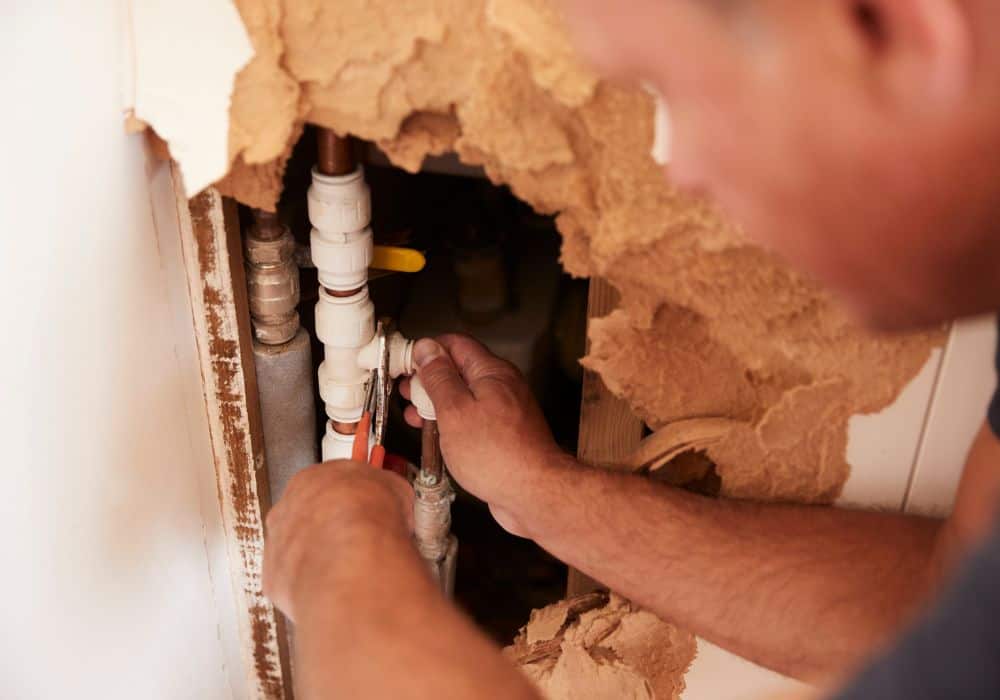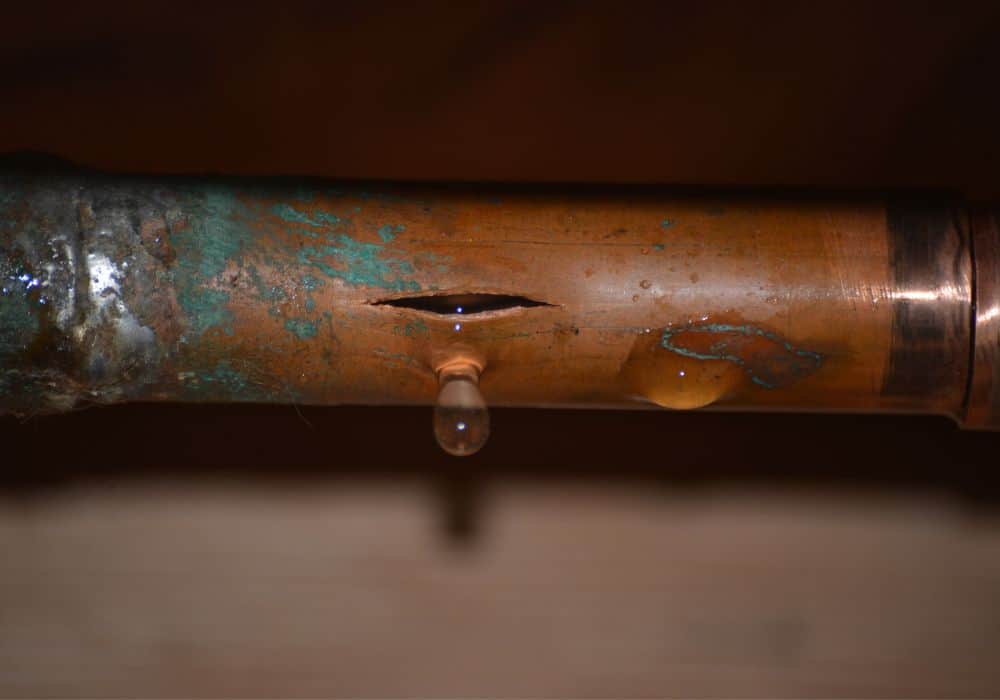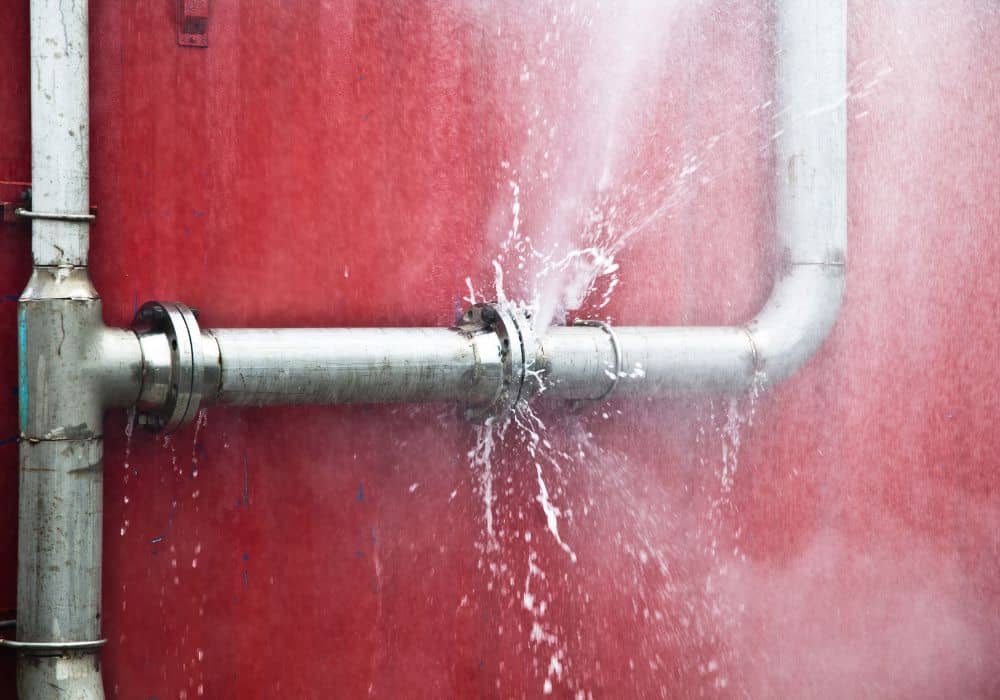Pipes are the backbone of our homes, supplying us with water and heat and taking waste away. But they are sadly not invincible, and over time you will undoubtedly come across a burst pipe at some point.
Burst pipes cause significant damage to your home and, if left unchecked, cause thousands of dollars worth of damage in repairs. Not only that, but often they become a health hazard that requires immediate attention for your safety.
This article will go through various scenarios to help you estimate and calculate the cost of fixing your burst pipe. Whether you fix it yourself or hire a professional, we’ll talk you through what you can expect to pay, what factors influence the cost, and share expert tips to save money.
The average repair costs of a burst pipe
There are two avenues to consider when fixing a pipe, hiring a professional plumber (who usually will include all the labor and equipment in their estimates) or sourcing the materials and repairing the pipe yourself.
Hiring a professional
The price of fixing a burst pipe can depend on several factors, which we will cover later on in this article. But to give you an idea of the average spending, we’ve gathered the average industry figures for hiring a professional plumber.
Price comparison site Thumbtack collects millions of people’s estimated quotes from professionals and has summarized the hourly costs of hiring a professional plumber. They include:
- National average cost: $110 per hour
- Low-end repairs: $55-$65
- High-end repairs: $185-$195
Expert Tips: Ask for a free estimation of costs to give you a ballpark figure to work with. Also, ask if the plumber’s work and replacement parts are under warranty to future-proof repairs and protect yourself from future breakages.
Repairing the pipe yourself
If you want to replace the pipe yourself, the core cost boils down to the pipe material. The average prices from Home Advisor state that the average cost can be between $0.50 and $30 per linear foot of piping, but the type of materials, the length you need them at, and their availability all factor into the price.
On average, plastic pipes are much cheaper. If you’re using metals, like copper or cast iron, these will cost more and may require being cut by a professional to your desired measurement.
To give you an idea of the differences in prices, consider the average cost of piping per linear foot:
- PVC pipe -$4.25
- Galanzied metal pipe -$6.50
- Polypropylene pipe -$8
- Fiberglass pipe -$8
- Copper pipe -$8.50
- Cast iron pipe -$20
Expert tips: Depending on the damage and your skill level, you may be able to fix the pipe with a simple solder or clamp. Furthermore, you don’t have to replace lines with the same material – some pipes, like PVC, can work with other materials.
Cost guide: what adds to the cost of fixing a burst pipe?

Every homeowner’s plumbing system is unique. Below are just some factors that can contribute to high repair costs.
1. The extent of the damage & stopping water
The true price of fixing a broken pipe should include the damage it causes.
Excessive water damage and moisture build-up may corrode your other piping and lead to an endless list of repairs in the future, including a high water bill. Water leakage can also compromise your electrical appliances, requiring a qualified electrician and doubling labor costs.
To limit this, turn off the water supply if you suspect a pipe has burst. Common symptoms of a malfunctioning pipe include lower water pressure, foul smells from drains, and puddles forming at sinks and faucets.
2. Where exactly is the pipe?
Location is one of the most critical factors that affect the cost of repairing a pipe. If the leak is in a hard-to-reach place, it complicates how you or the plumber can work.
Firstly, you might be unable to correctly identify the leak if pipes are laid behind drywall or concrete slabs, or in the case of sewer lines, you might have to tunnel deep underground
If your repair job requires heavy machinery to drill through materials, this adds to the repair’s premium cost. Rooms like the bathroom may also have expensive tiling that must be removed to access pipes around showers and toilets, too.
On the flip side, easy-to-reach, exposed pipes (like those under a kitchen sink) or pipes laid simply in a basement or ceiling are often easier to examine and much cheaper to repair and replace.
3. Emergency fees
Sadly, the urgency of the repair may cost you significantly, as plumbers charge emergency fees to call out straightaway, ranging between $50-$150 extra on top of your price.
If your water leak is small and slow, you may be in a position to wait for a regular appointment. But if your main water line has burst, you will need to pay a premium for timely service.
4. Damage from temperature
The cause of the pipe bursting can also carry additional costs. Temperature is often a common cause of our plumbing breaking down.
Freezing temperatures cause water in pipes to expand, rupturing them and causing significant damage throughout your system. This often requires replacing more than one pipe, too, unfortunately, as frozen water tends to linger in your entire system.
When repairing pipes, if frozen water is still inside, you or your plumber need to thaw it out, costing you more per hour.
5. Corrosion
Corrosion occurs when hard water laden with minerals damages the structural integrity of your plumbing system. It is especially damaging to older plumbing systems like cast iron pipes. Rust, water discoloration, and foul odors are all signs of a corroded pipe and must be repaired.
Sadly, if one pipe shows evidence of corrosion, it is more than likely, the rest of your system is failing, too. We recommend replacing your entire system with a modern, chemically-resistant pipe like PVC to deal with modern chemicals found in water.
6. Tree roots
Nearby root systems from trees can pierce pipes outside your home over time. This can cause burst pipes in critical locations where the roots are expanding and may require additional services like a tree surgeon to cut the roots away. If roots are expansive, you may need to redirect your pipelines to avoid future damage, leading to a challenging plumbing job.
7. Does insurance cover pipe repairs?
Ultimately, this depends on your policy. Quite often, water damage from a burst pipe caused by some unforeseen event (like weather) can be covered.
But if the cause of the burst from ice was down to deterioration or corrosion of pipes over a long period, and you neglected to repair them, your insurance may refuse to cover the damage. This is because they often don’t cover “wear-and-tear” incidents. Contact your insurer for specific details on burst pipe coverage if in doubt.
Cost-cutting tips:
Below are some tips to help you reduce the cost of fixing burst pipes. While they might not cover the entire cost, every little will help!
- When a pipe bursts, turn off the water supply and electricity in the room immediately to limit any further water damage cleanup and costs.
- When replacing pipes, you may be able to make savings by changing the type of pipe to a cheaper but equally resilient material.
- Common causes of pipe bursting include tree roots, freezing, corrosive chemicals, mold, incorrect installation, shifts in the soil, and improper water pressure. Addressing these concerns can drastically limit bursting.
- Regular inspections (every two years) can help you detect early signs of structural damage and replace them before a burst.
- Where the pipe is influences price – a broken water pipe connected to a bathtub will be more complicated to fix than a kitchen sink, for example.
- Always factor in the replacement cost of the pipe together with labor costs.
- Ask if your plumber’s work and fixtures are protected and guaranteed under warranty.
- Only hire qualified professionals. Ask for their qualifications and review previous customer testimonials.
- Many plumbers offer a free estimation of the work involved. Ask if prices are all-inclusive, including the pipe replacement and labor costs.
- Always check your home insurance to see your coverage against broken or burst pipes. It may even help cover subsequent water damage.
Conclusion
At some point in time, our pipes will fail us, and we will be faced with burst pipe repairs. This is unavoidable. But preparation is your best line of defense against limiting damage and the cost of fixing it.
In this article, we’ve shown you what prices you can expect to pay when fixing your pipes. We’ve also discussed the different prices of materials to help you make an informed decision about the future of your plumbing system.
As with any plumbing work, shop around different contractors and compare them in terms of price, time spent working, customer reviews, and whether there is a guarantee on their work.
If you are in the process of fixing a burst pipe and have questions about the best prices you can expect, please leave a comment below.
As always, remember:
- Suspect a burst pipe? Turn off the water immediately!
- A solder or clamp can be a temporary fix until you get more information
- Shop around – plumbers can be competitive with their prices if it’s not an emergency.
- Don’t think you have to stay with the same material pipe – consider upgrading them to future-proof your plumbing system.


